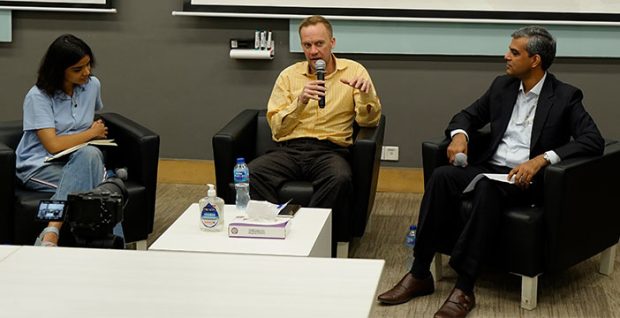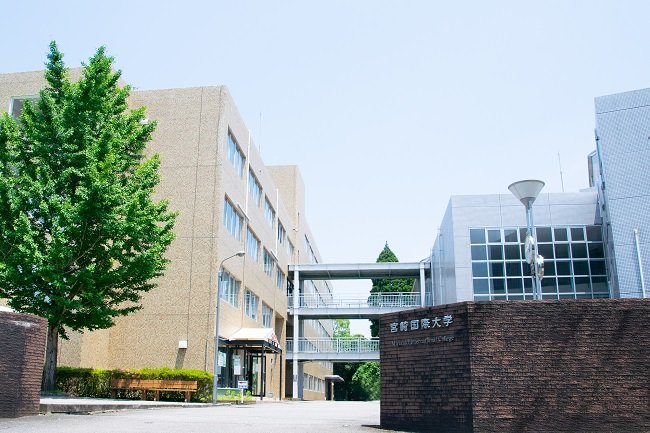Miyazaki International University, a small university with around 600 students, was ranked 8th in the “Internationality” category of the “THE World University Rankings Japan 2021,” released in March. Since opening in 1994, the university has consistently promoted “liberal arts in English” and “compulsory overseas training” as its features, and has become a model for global universities and faculties. We introduce the university’s systems for “serious global human resource development,” including its intensive overseas training programs and unique employment system that encourages faculty members to make efforts to improve their teaching skills.
●The chairman of the board of directors was convinced that “liberal arts is the ideal education” and established the university.

Miyazaki International University’s ranking for “internationality” in the “THE World University Rankings Japan Edition 2021” is 8th, up 11 places from last year’s 19th place tie. The university’s educational fulfillment based on high school teacher surveys and student surveys is tied for 101st place, placing it within the top 100, and its overall ranking has risen from 151-200 last year to 121-130. Naoki Nishimura, Director of the Global Education Center, who also serves as assistant to the president, explained, “We actively participate in rankings and surveys that can highlight our strength in internationality and disclose the data.” His words reveal his pride that “self-study is the pioneer of global human resource development in Japanese higher education.”
Miyazaki International University consists of two faculties: the Faculty of International Liberal Arts (100 students) and the Faculty of Education (50 students). The university opened in 1994. The then-president of Miyazaki Gakuen, which has a junior high school, high school and junior college, Hisayasu Otsubo, felt that “liberal arts is the ideal education required for Japanese universities, which place too much emphasis on knowledge,” and founded the university as a single-discipline university with only a comparative culture department. While working at the Technical Research and Development Institute of the Defense Agency (now the Ministry of Defense), he was assigned to the U.S. Naval Center as an exchange researcher. He said that his interactions with American researchers there were his formative experience of the value of a liberal arts university.
”The starting point of our university was President Otsubo’s philosophy that students should gain freedom of mind and knowledge through liberal arts, and develop the ability to see things from various angles and derive their own opinions,” explains Director Nishimura. From the beginning, the university has placed emphasis on critical thinking and incorporated active learning into all classes. In anticipation of the arrival of the global era, all classes are taught in English and overseas training is now compulsory. The pillar of education is always liberal arts, and the idea is to improve English ability through learning in that field.
In 2006, the faculty’s name was changed to the Faculty of International Liberal Arts, and in 2014, the Faculty of Education was established.
●The ratio of foreign faculty members in 2021 will be 77%.
Looking at the four indicators of “internationality” in the “THE World University Rankings Japan Edition” using the most recent data for the Faculty of International Liberal Arts, we see the following.
・As of April 2021, the ratio of international students is 12%. Students are accepted from Korea, China, Cameroon, Vietnam, Nepal, Kazakhstan, and other countries.
・As of April 2021, 24 of the 31 full-time faculty members (77%) are foreigners. Dean Anderson Passos is also a Brazilian national.
・The percentage of students who experience studying abroad before graduation was 82% in 2020 (some students do not participate in overseas training due to financial or health reasons).
・The percentage of classes offered in English in 2019 was 88%.
The ranking uses the combined and averaged data for each of these indicators for a specified period with the Faculty of Education.
● Japanese language proficiency is also important in improving English skills

Here is an overview of the curriculum of the School of International Liberal Arts, which incorporates various measures that have led to the school’s “8th place in internationality” ranking.
In the first semester of the first year, students take five subjects taught in English. Two of these are selected from subjects related to humanities, social sciences, and general sciences. These classes are team-taught by experts in each field and English language education experts. The remaining three subjects are English oral communication, reading, and academic writing, and classes are organized according to proficiency level.
In addition to English proficiency, Japanese language proficiency is also emphasized, and “Japanese Expression” is a compulsory subject from the first to third years. “No matter how excellent the English education a university provides, it is impossible to make students fluent at native level, and there is no need to do so. For Japanese people, true English proficiency is the ability to communicate using the most appropriate expressions after deeply understanding Japanese culture and ways of thinking. To achieve this, it is essential to improve your Japanese language skills,” says Center Director Nishimura.
Most subjects are offered two classes a week, and the curriculum is American-style, with students studying a small number of subjects intensively to steadily improve their skills.
During the overseas training, participants submitted three reports in English.
In the first semester of the second year, students take English courses and “Japanese Expression,” as well as interdisciplinary and career-related courses such as “Culture of English-speaking Societies” and “Contemporary Japanese Art and Culture.” Some of these courses are also taught through team teaching.
In the second semester of the second year, students undergo a mandatory overseas study program (about 16 weeks) and are sent to 15 partner universities in five English-speaking countries, including the United States, Canada, and Australia. Students are expected to develop their own way of thinking and independence while utilizing their liberal arts and English skills in a different culture. While studying intensive English courses at partner universities, students are required to write a report in English of a total of 15,000 words on three themes during their stay. In “English,” students report on their English studies, mainly in class, and in “Area Studies,” students summarize their experiences and impressions in a different cultural society. In “Independent Research,” students work on a thesis on a theme related to the country, incorporating data from questionnaires and interviews.
After returning from their overseas training, students choose to study from humanities, social sciences, or special studies (four fields: English-speaking language and culture, international society and culture, global studies, and psychology) from their third year, and write their graduation thesis in their fourth year.
In 2020, due to the spread of the COVID-19 infection, the overseas training program was canceled. Joint classes with partner universities were held online. In-house faculty and local faculty worked together to set up a program to explain the history and culture of each country, and students were given the opportunity to interact with local students, working on writing reports for “area studies” and papers for “independent research.”
As of late April, the situation is also difficult for students to send students to the program in 2021. With the deadline for visa application procedures approaching in early June, it seems that difficult decisions will be forced upon them, with the possibility of implementing the program online in mind.
●Teachers are employed on a fixed-term basis, and those seeking reappointment must present evidence of their teaching ability
The School of International Liberal Arts, where the majority of faculty members are foreign, has a unique employment system that “maybe is unique among Japanese universities” (Center Director Nishimura).
All faculty members, including the dean and Japanese faculty, are on a two-year contract as a rule. Faculty members who wish to renew their contracts must record their achievements, mainly related to education, such as challenges in classes and student evaluations of their classes, in a teaching portfolio and submit it to a reappointment committee selected by the faculty council. Based on the results of the review, the dean and then the president decide whether or not to reappoint the faculty member, and the contract renewal is approved by the chairman of the board of directors.
This system, which allows faculty members to continue to hone their teaching skills without being complacent with permanent employment, has been maintained since the university’s founding. Most faculty members who wish to be reappointed are actually reappointed, but this is not because the system has become a mere formality, but because the culture has become one in which it is normal to strive to improve the quality of classes.
● Student recruitment improves with expansion of scholarship system

At first, the school struggled to recruit students, as it was slow to accept its advanced education, including liberal arts in English and compulsory overseas training. In 2003, the number of students enrolled was reduced by 50.
However, in response to the growing social need and interest in nurturing global human resources, the number of students enrolled has gradually increased in recent years. In 2016, there were 57 students out of a total of 100, but this number increased to 68 in 2017, 87 in 2018, and 120 in 2019, reaching the full capacity, and 117 in 2020.
Education reforms, entrance exam reforms, and the expansion of scholarship systems, as well as strengthened public relations activities such as high school visits, guidance sessions, and open campuses to communicate these changes, have led to an improvement in student recruitment. Regarding the scholarship system, there are many slots for full or half tuition exemptions for students with high scores in the general selection and selection using the National Center Test, and those who have cleared the performance standards for external English proficiency tests at high school.
Even if you do not meet these criteria at the time of admission, there are many opportunities to receive scholarships after admission, such as academic performance, results in external English proficiency tests, and achievements in fields such as arts and sports. From 2021, a new grant-type scholarship will be introduced with support from the local business community. The university
has also started to focus on utilizing the media. A few years ago, the university’s website was completely redesigned . The site has a lively impression, with many videos introducing the campus, teaching videos in English, and videos answering questions from applicants in English, such as “What is a liberal arts education?”
The “Data-based International Liberal Arts School” page highlights various data, including the “internationality” index from the “THE World University Rankings Japan Edition.” It also shows that the average TOEIC score for fourth-year students in 2020 was 675 points, significantly higher than the 583 points for all English majors.
Consider shifting to “liberal arts with an exit strategy”
Due to the COVID-19 pandemic, it has become difficult to study abroad, and the number of applicants to international and foreign language faculties for the 2021 entrance exams has dropped significantly. The number of students admitted to the Faculty of International Liberal Arts at Miyazaki International University has again fallen below its capacity, to 79.
With no end in sight to the COVID-19 pandemic, President Murakami Noboru, who took office this spring, is working on a strategy to appeal to prospective students by solving the essential problem of brushing up education. In order to address the weakness of liberal arts, which is that it is difficult to imagine an exit, he is considering establishing courses with specific exits in mind and presenting model curricula and curriculum flow charts. He is also considering reviewing the content of compulsory subjects so that they can be converted into credits for teacher training courses, thereby reducing the burden on those who wish to become teachers. He
said that he has cooperated with some of the succeeding universities and faculties that have set the goal of “classes in English” and “mandatory overseas training” in the planning stage by conducting inspections and interviews. Director Nishimura says, “I am proud that our philosophy was ahead of its time and was widely sought after by society.” Based on its founding principles and pride as a pioneer in nurturing global human resources, the future of this small university is attracting attention as it aims to establish a unique position.

Leave a Reply